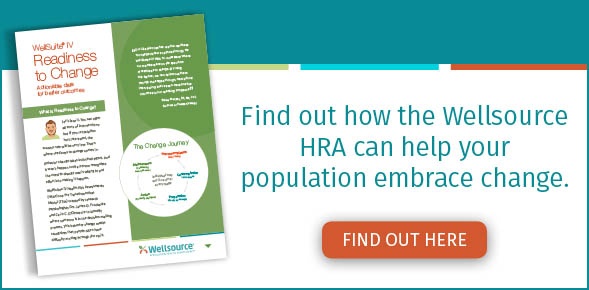Typically, springtime is met with a sense of renewal. People are ready to start eating healthy and hitting the gym after months cooped up inside — and it’s a great time to begin implementing wellness initiatives. This year, amid the COVID-19 pandemic, it may be difficult to implement some of the initiatives you had planned. As many countries are virtually shutting down, it’s understandable that more pressing concerns are taking up people’s attention. We still have the same good intentions to improve overall health and wellness, but there’s absolutely an added focus on adjusting to working remotely, avoiding crowds, and remaining indoors. In the midst of this, trying to figure out how to prepare fresh foods and make time for the gym is likely to be low on the to-do list.
We’ve written before about how population health can impact work culture and vice versa. Now it’s becoming more important than ever for individuals to take stock of their health and wellness and make adjustments when possible.
Although we’re currently in a unique situation, the ways to work with your population to promote wellness remains relatively unchanged. The first step is to build a data-driven program with a reliable and trustworthy health risk assessment (HRA). From there, providing your partners and their populations with personalized programs that will resonate and encourage participation helps them get the most out of their portal and wellness experience.
To help boost your wellness program planning, we’ve got a few ideas that you can present to your population or partners. These suggestions will likely benefit everyone in nearly any situation, and not just those at risk for certain ailments as we navigate the COVID-19 crisis.
Embrace the Outdoors
 As the weather warms up and the days get longer, there’s nothing better than enjoying the great outdoors, whether it’s heading outside or simply enjoying some fresh air through an open window. In fact, spending time outdoors has been proven to improve health and reduce stress, especially as it relates to the workplace, and scientists recommend opening windows to increase fresh air circulation to help combat Coronavirus circulation.
As the weather warms up and the days get longer, there’s nothing better than enjoying the great outdoors, whether it’s heading outside or simply enjoying some fresh air through an open window. In fact, spending time outdoors has been proven to improve health and reduce stress, especially as it relates to the workplace, and scientists recommend opening windows to increase fresh air circulation to help combat Coronavirus circulation.
When making recommendations to your partners or population, include activities that can be completed outside. We aren’t saying you have to recommend they all go on a nature walk every week, but making some small tweaks to a daily routine could provide just enough nature time for people to begin seeing benefits.
Some things to recommend are:
- Taking a stroll while they enjoy their morning coffee or during their lunch break.
- Moving their daily workout from the gym to the roads or backyard.
- Checking off some items on their to-do list by working in the yard.
- Getting more natural light to offset disruptions to our biological clocks.
We realize that as seasonal allergies begin cropping up, some people may opt to stay indoors. For those looking for a workaround, heading outside during low-pollen times of day (after 10am) and doing a quick cleanup of skin and clothes is a good way to minimize allergy issues.
Deep Clean
Springtime is frequently paired with feelings of freshness and new beginnings, and many people take the opportunity to get into heavy spring cleaning. This is a great way to clear out the literal clutter that has accumulated through the colder months and gain more usable space. Cleaning out clutter can also have a positive effect on your mental health. Studies have shown that people who identify as having a “cluttered” home have higher stress and cortisol levels than those who don’t. The benefits don’t stop there—if your spring cleaning leads to a large pile for the donation bin it turns out that giving to charity can also have a positive impact on mental health!
Deep cleaning can also be good for your physical health by allowing you to remove dust, allergens, toxins, and—of course—germs. We aren’t saying that you must recommend your population deep clean their entire space every year to ensure health and wellness, but including recommendations for specific activities is a good way to get the ball rolling. These activities can include simple things like:
- Archiving or throwing away unneeded files.
- Organizing closets and dressers and donating unwanted clothing.
- Changing air filters in home heating and cooling systems to improve indoor air quality.
Of course, there are some specific recommendations for implementing COVID-19 cleaning measures. These include:
- Washing hands frequently for 20 seconds with warm, soapy water.
- Hand sanitizing regularly.
- Using approved disinfectants (typically that contain bleach) to wipe down surfaces including doorknobs.
While these may not be the usual wellness initiatives that you consider implementing, they’re always good reminders to pass along to your population, especially those who may be prone to illness due to chronic disease or compromised immune systems.
Stress and Schedule Management
One often-overlooked components of wellness is stress management. People tend to focus on the measurable aspects of their health—weight, blood pressure, etc.—that they forget that high stress and poor mental health can impact those things. Of course, the occasional stressful day is normal—and could actually be good for you—but if someone’s day-in-day-out existence is fueled by high stress, they’re going to see negative health effects. Stress raises cortisol levels which, in turn, can impact weight, blood pressure, and sleep. Stress can also have a negative impact on the immune system, which during this time is pretty much the last thing anyone needs to be worrying about. (The CDC has some additional tips on managing mental health as it relates to COVID-19 here.)
The best way to mitigate the effects of a stressful lifestyle—especially if you can’t remove the stressor entirely—is to practice stress management techniques. There are tried and true methods to reduce stress, like making sure you’re getting enough sleep, reducing caffeine intake, exercising, and eating a healthy diet are all important. Other strategies include taking control of your schedule, setting boundaries for work/life balance, and being sure to carve out some time for yourself each day (even if it’s only 15 minutes).
When presenting these options to your population, provide them with a few simple ways to start, such as:
- Blocking off designated administrative and email time in their calendars to avoid feeling pressure to answer every message as soon as it comes through.
- Setting reminders to get up and stretch and drink some water once an hour.
- Encouraging them to step away from their desk at lunch and fully “log off” at the end of the day, especially if they’re working from home.
- Spending 15 minutes reading or meditating before bed rather than falling asleep with the TV on or scrolling through social media.
These tips are doubly important while individuals are working from home, since it can be easy to slip into a non-stop work mindset once the home office is set up.
As we mentioned earlier, these are the types of tweaks that nearly anyone can make—not just people who have a specific health goal in mind. However, one of the key components of a successful wellness program is making sure that your population is ready, willing, and able to make changes. In our guide, Change Readiness: The Critical Component to Wellness Engagement, we’ll take you through the ins and outs of a change readiness program that will ensure long-term, sustainable population participation so that you can have confidence in the success of your wellness initiatives.








